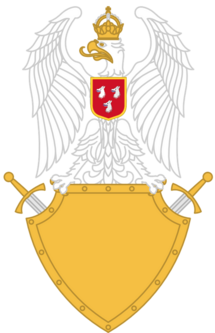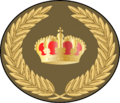National Army of Vozh
| Vozhsk National Army | |
|---|---|
| Vozhskaja Nacyjanaĺnaja Armija | |
 Emblem of the National Army | |
| Active | 1911 |
| Country | |
| Allegiance | Monarch of Vozh |
| Branch | Vozhsk Armed Forces |
| Type | Army |
| Role | Land warfare |
| Size |
|
| Garrison/HQ | Ministry of National Defence |
| Motto(s) | Съ Нами Богъ (God With Us) |
| March | Advance! |
| Commanders | |
| Commander-in-Chief | High King Viktoriya |
| Commander | General Eglė Kulėšiūtė |
| Colonel of the Regiment | Ahmed Luhashenkha |
| Insignia | |
| Flag |  |
The Vozhsk National Army (Vozhsk: Vozhskaja Nacyjanaĺnaja Armija) is the main infantry force of the The United Kingdoms of Vozh. As of 2081, the National Army fields more than 988,000 personnel. It is the largest branch of the Vozhsk military, being responsible for the active infantry corps and the infantry reserve. It maintains bases across the nation, with units during peace-time being assigned to various regional commands.
The Vozhsk National Army has its origins in the 1913 War of Independence, where it was formed by the merger of several independent militias. The VNA is administered by the Defense Commissariat and commanded on behalf of the General Staff by the Commander of the Army.
History
Modernization
Shortcomings and high casualties in the 2016 Halkeginian Conflict laid bare the need for a drastic modernization in the VNA's organization and equipment.
Structure
The High King of the Vozhski is formally the commander-in-chief of the Vozhsk Armed Forces. The Vozhsk Constitution gives the Prime Minister authority to appoint the Defense Commissar, to be confirmed by the House of People's Representatives, with the position currently being held by Abram Litwak. The current commander of the National Army is General Eglė Kulėšiūtė.
Branches of Service
The National Army is divided into several service branches, among them being the motorised rifles, the shock rifles, armoured cavalry, the missile and artillery troops, the air defense troops, the special corps (reconnaissance, signals, radioelectronic warfare, engineering, nuclear, biological and chemical protection, logistical support, automobile, and the protection of the rear), and the logistical troops.
The Motorised Rifles, the most numerous service branch, are the basic infantry unit that the other service branches work to support. They are equipped with modern line infantry equipment, with a powerful array of squad support weapons, light mortars, and armoured transport vehicles at their disposal. They also possess sophisticated armored scout cars in addition to motorcycle and horse-borne specialists for operating in the mountainous terrain of Vozh which often makes it it impossible to deploy more modern reconnaissance platforms. The Motorised Rifles, as the primary line infantry, are intended to follow the forward shock forces, to maintain and exploit the gaps they create in the enemy front line. As of 2016 there are 24 Motorised Rifle Divisions in active service.
The Tank Troops and Shock Rifles are intended to be the primary strike units of the National Army. Their role is to attack weak spots in the enemy line, drive through them, and bypass the main resistance, focusing on attacking the enemy's depth. Thus, their primary targets are enemy communication lines, munitions depots, fuel depots, rail lines, highways, and command post. Equipped with modern tanks, APCs, IFVs, and mortar carriers, these units are capable of bringing devastating firepower to bear and are the most formidable regular forces at the National Army's disposal.
The Artillery and Missile forces have potentially fared the worst of all of the service branches. Lacking the budgetary priority given to the other branches, most units are equipped with aging platforms. Some of the SPGs and and MLRS have been in service for over thirty years, with their last major reform having been in the 1990s, which saw the equipment of the artillery troops with GPS-assisted calculation tables and improved range-finding and surveying equipment.
Disposition
As of 2016, two field armies are assigned to the Western Military District, with a third to the Eastern Military District. Furthermore, one independent army corps is assigned to the easr, and three to the west.
Equipment
Rank structure
Insignia
Commissioned officer
| Field Marshal Fieĺdmaršal |
General General |
Lieutenant General General-leytenant |
Major General General mayor |
Brigadier General Brigadnyy general |
Colonel Polkovnik |
Lieutenant Colonel Leytenantekurnal |
Major Mayor |
Captain Kapitan/Rytmester |
First Lieutenant Vialika leytenant |
Second Lieutenant Leytenant |
Officer cadet Kornat | |
|---|---|---|---|---|---|---|---|---|---|---|---|---|
| OF-10 | OF-9 | OF-8 | OF-7 | OF-6 | OF-5 | OF-4 | OF-3 | OF-2 | OF-1 | OF-(D) | ||

|

|

|

|

|

|

|

|

|

|

|

| |
Non-commissioned members
| Sergeant Major Adzhetant |
Staff Sergeant Sterzhni vozhd |
First Sergeant Aporavokhmestra/Sterzhin |
Sergeant Vokhmostra/Vozhd |
Master Corporal Vialika kapral |
Corporal Karparel |
Private Saldet/Husar/Kananier | ||
|---|---|---|---|---|---|---|---|---|
| OR-9 | OR-8 | OR-7 | OR-6 | OR-5 | OR-4 | OR-3 | OR-2 | |

|

|
No equivalent | No Insignia |